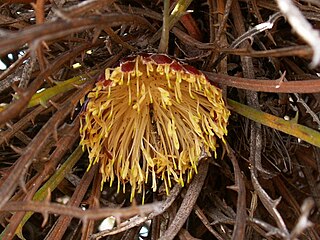
Arbor Day is a holiday in which individuals and groups are encouraged to plant trees. Today, many countries observe such a holiday. Though usually observed in the spring, the date varies, depending on climate and suitable planting season.

Banksia gardneri, commonly known as prostrate banksia, is a species of prostrate shrub that is endemic to Western Australia. It has pinnatipartite or serrated leaves, usually rusty brown flowers, and up to twenty-five elliptical follicles in each fruiting head. It occurs along the west part of the south coast of the state.

Banksia occidentalis, commonly known as the red swamp banksia, is a species of shrub or small tree that is endemic to the south coast of Western Australia. It has smooth bark, linear, sparsely serrated leaves, golden flowers in a cylindrical spike, and later up to sixty follicles in each spike.

The 3M Company is an American multinational conglomerate corporation operating in the fields of industry, worker safety, US health care, and consumer goods. The company produces over 60,000 products under several brands, including adhesives, abrasives, laminates, passive fire protection, personal protective equipment, window films, paint protection films, dental and orthodontic products, electrical and electronic connecting and insulating materials, medical products, car-care products, electronic circuits, healthcare software and optical films. It is based in Maplewood, a suburb of Saint Paul, Minnesota.

Banksia cirsioides is a species of shrub that is endemic to Western Australia. It has pinnatisect leaves with between six and ten lobes on each side and hairy heads of yellow and pink flowers.

Banksia comosa, commonly known as Wongan dryandra, is a species of shrub that is endemic to Western Australia. It has linear leaves with widely spaced, sharply pointed serrations, heads of yellow flowers and glabrous fruit.
Banksia fuscobractea, commonly known as the dark-bract banksia, is a species of shrub that is endemic to a small area in the south-west of Western Australia. It has prickly, serrated, wedge-shaped leaves, pale yellow and cream-coloured flowers in heads of up to almost two hundred, and three or four egg-shaped follicles in each head.
Banksia seneciifolia is a species of column-shaped shrub that is endemic to the south-west of Western Australia. It has linear, pinnatifid leaves, yellow flowers in heads of about twenty-five, and narrow egg-shaped follicles.

Banksia serra, commonly known as serrate-leaved dryandra, is a species of shrub that is endemic to Western Australia. It has broadly linear, serrated leaves, pale yellow flowers in heads of about thirty and egg-shaped follicles.

Banksia serratuloides is a species of small shrub that is endemic to Western Australia. It has linear, pinnatipartite leaves, yellow and pink flowers in heads of about forty and hairy, wrinkled follicles.

Solar power in Australia is a fast growing industry. As of June 2020, Australia's over 2.4 million solar PV installations had a combined capacity of 18,583 MW photovoltaic (PV) solar power, of which 3,290 MW were installed in the preceding 12 months. In 2019, 59 solar PV projects with a combined capacity of 2,881 MW were either under construction, constructed or due to start construction having reached financial closure. Solar accounted for 5.2% of Australia's total electrical energy production in 2018.

Grevillea treueriana, also known as Mount Finke grevillea, is a shrub that is endemic to Mount Finke in South Australia. It is listed as vulnerable under the EPBC Act.

The National Herbarium of Victoria is one of Australia's earliest herbaria and the oldest scientific institution in Victoria. With 1.5 million specimens, it houses the largest collection of pressed, dried plant specimens in Australia, including scientifically and historically significant collections gathered by Joseph Banks and Daniel Solander during the voyage of HMS Endeavour in 1770, 2,000 specimens collected by Robert Brown during Flinders' circumnavigation of Australia (1801–1805), and three collections made by Darwin during the Voyage of the Beagle to South America, Australia, and the Pacific. The herbarium was established in 1853 by Ferdinand von Mueller, the Government Botanist for Victoria, and is situated within the Royal Botanic Gardens, Melbourne. The present building was constructed in 1934 through a donation from philanthropist Sir Macpherson Robertson. It, along with a 1989 extension, houses the entire collection of 1.5 million plant and fungal specimens. The Herbarium's botanic library is an important source for the history of Australian botany, and has contributed some 124 volumes to the online digital Biodiversity Heritage Library.

Gahnia is a genus of sedges native to China, Southeast Asia, New Guinea, Australia, New Zealand and a number of Pacific Islands. The common name is due to the toothed margins. It often forms tussocks.
Banksia gardneri var. gardneri is a variety of Banksia gardneri. As an autonym, it is defined as encompassing the type material of the species. It is native to the Southwest Botanical Province of Western Australia.

Banksia gardneri var. brevidentata is a variety of prostrate shrub that is endemic to the south-west of Western Australia.
Cyphochlaena is a genus of plants in the grass family native to certain islands in the Indian Ocean.

Miami Horror are an Australian electronic music group from Melbourne, Victoria, Australia. Miami Horror was initially formed by its producer and DJ, Benjamin Plant who began it as a solo project. In addition to Plant, the band features Josh Moriarty, Daniel Whitechurch (keyboards), and currently Rhythm Luna (drums), though they often feature different vocalists. The band takes influence from dance and rock artists of the 1970s and 1980s such as Prince, New Order, Todd Rundgren, and Pink Floyd, combining it with modern production techniques from styles such as house and pop music.

Dominion is an Australian documentary released in 2018 by Chris Delforce. The film shows the many ways in which animals are regularly abused. A total of six facets are illuminated: farm animals, wild animals, companion animals, entertainment animals, fur animals, and animal experimentation.

Franklandia fucifolia, or lanoline bush, is native to the south-west of Western Australia. It is a species in the Franklandia genus of the Proteaceae family.
















